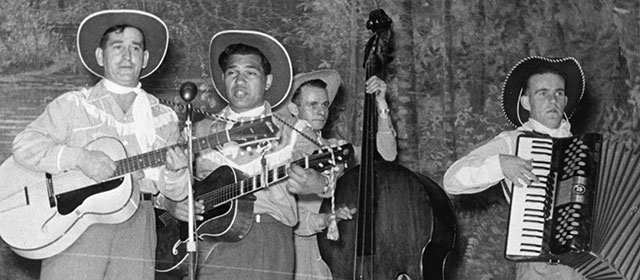He korero whakarapopoto
Early folk music
Folk music is music played by the people rather than by elites. Songs evolve as they are passed on from person to person. They can praise heroes, mourn tragedies and act as social comment or protest.
Māori had a rich musical culture before Pākehā arrived. European sealers, whalers, sailors, gold miners and early settlers sang songs about their lives. Professional entertainers such as Charles Thatcher visited the goldfields, and some of his songs were adopted by miners and bushmen. Travelling shearers brought Australian songs to New Zealand, and soldiers and trampers also developed their own songs. From the mid-19th century Māori composers used European melodies.
Collection and revival
A number of people have collected early New Zealand folk songs.
There was a folk-music revival in the 1950s and 1960s, with musicians performing in cafés. The New Zealand Folklore Society was set up in 1966, and Christchurch singer Phil Garland began collecting and playing folk songs. Many folk musicians were recorded, and acts such as the Hamilton County Bluegrass Band, Shona Laing and John Hanlon became well-known. In the 2000s folk clubs and festivals were thriving.
Early country music
Country music grew out of folk music, as British immigrants to the US transformed traditional songs. New Zealanders adapted country music to describe their own country.
From the 1920s records by American country acts were available in New Zealand, and some visited. In 1932 Robert Lane made demonstration discs in Wellington – some of the world’s earliest country recordings outside America. He moved to Australia and had a long musical career as Tex Morton.
The Tumbleweeds, set up in 1949, were a popular country band.
Country music, 1950s onwards
The early recording industry promoted many local country singers. Johnny Cooper, known as the ‘Māori cowboy’, covered American songs. From the 1960s artists such as Peter Posa and Maria Dallas were played on the radio, and John Hore and Eddie Low released records. The country touch (1968–69) and That’s country (1976–83) were popular TV shows, featuring musicians such as Patsy Riggir, Brendan Dugan and the Topp Twins. The Gold Guitar Awards for country musicians were held each year in Gore. In the 2000s some artists played ‘alt country’ – combining country and alternative rock influences.
The blues
Blues music has African-American roots. New Zealand jazz musicians played blues instrumentals from at least the 1930s. By the mid-1960s acoustic blues was performed at folk clubs, and rhythm-and-blues-styled pop bands played electric blues. Original blues songs were written locally from the late 1970s.





